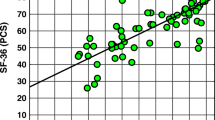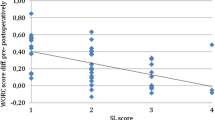Abstract
To adapt the Western Ontario Rotator Cuff (WORC) index for use in Turkey and to investigate its reliability and validity; the Turkish version of the WORC was developed according to the guidelines in the literature. Seventy-two patients with rotator cuff disease were administered the questionnaire and were also evaluated by using the University of California Los Angeles (UCLA) shoulder rating scale, Constant score, and Short Form (SF)-36 to test validity. The WORC questionnaire was repeated in 35 patients after a mean interval of 2.9 days (range 2–7 days) to evaluate test–retest reliability. Cronbach’s alpha was calculated as 0.92 for the total questionnaire. The intraclass correlation coefficients were very high and ranged between 0.96 and 0.98 for each section. There was a significant negative correlation between the Turkish version of WORC and UCLA (r = −0.598, P < 0.01), Constant score (r = −0.630, P < 0.01), and all subscales of SF-36 (P < 0.01). The Turkish version of the WORC index is a reliable and valid instrument for use in clinical trials in patients with rotator cuff disorders.
Similar content being viewed by others
References
Guyatt GH, Feeny DH, Patrick DL (1993) Measuring health-related quality of life. Ann Intern Med 118:622–629
Kirkley A, Griffin S (2003) Development of disease-specific quality of life measurement tools. ISAKOS Scientific Committee Report. Arthroscopy 19(10):1121–1128
Kirkley A, Griffin S, Dainty K (2003) Scoring systems for the functional assessment of the shoulder. Arthroscopy 19(10):1109–1120
Ware JE, Sherbourne CD (1992) The MOS 36-item short-form health survey (SF-36): I. Conceptual framework and item selection. Med Care 30:473–483
Ware JJ, Kosinki M, Keller SD (1996) A 12-item short-form health survey: construction of scales and preliminary test of reliability and validity. Med Care 34:220–233
Rekola KE, Keinannen KS, Takala J (1993) Use of primary health services in sparsely populated country districts by patients with musculoskeletal symptoms: consultations with a physician. J Epidemiol Community Health 47:153–157
Gomoll AH, Katz JN, Warner JJP, Millett PJ (2004) Rotator cuff disorders: recognition and management among patients with shoulder pain. Arthritis Rheum 50(12):3751–3761
Amstutz HC, Sew Hoy AL, Clarke IC (1981) UCLA anatomic total shoulder arthroplasty. Clin Orthop 155:7–20
Richards RR, An K-N, Bigliani LU, Friedman RJ, Gartsman GM, Gristina AG, Ianotti JP, Mow VC, Sidles JA, Zuckerman JD (1994) A standardized method for the assessment of shoulder function. J Shoulder Elbow Surg 3:347–352
Hudak PL, Amadio PC, Bombardier C (1996) Development of an upper extremity outcome measure: the DASH (disabilities of the arm, shoulder and hand). The Upper Extremity Collaborative Group (UECG). Am J Ind Med 29:602–608
Constant CR, Murley AHG (1987) A clinical method for the functional assessment of the shoulder. Clin Orthop 214:160–164
Roach KE, Budiman-Mak E, Songsiridej N, Lertratanakul Y (1991) Development of a shoulder pain and disability index. Arthritis Care Res 4:143–149
Michener LA, Leggin BG (2001) A review of self-report scales for the assessment of functional limitation and disability of the shoulder. J Hand Ther 14:68–76
Lippitt SB, Harryman DT II, Matsen FA III (1992) A practical tool for evaluating function: the Simple Shoulder Test. In: Matsen FA, Fu FH, Hawkins RJ (eds) The shoulder: a balance of mobility and stability. American Academy of Orthopaedic Surgeons, Rosemont, pp. 501–518
Kirkley A, Griffin S, McLintock H, Ng L (1998) The development and evaluation of disease specific quality of life measurement tool for shoulder instability: the Western Ontario Shoulder Instability Index (WOSI). Am J Sports Med 26:764–772
Lo IKY, Griffin S, Kirkley A (2001) The development and evaluation of disease specific quality of life measurement tool for shoulder: the Western Ontario Osteoarthritis of the Shoulder Index (WOOS). Osteoarthritis Cartilage 9:771–778
Kirkley A, Griffin S, Alvarez C (2003) The development and evaluation of disease-specific quality of life measurement tool for rotator cuff disease: the Western Ontario Rotator Cuff Index (WORC). Clin J Sport Med 13:84–92
Freeman KB, Back S, Bernstein J (2001) Sample size and statistical power of randomized, controlled trials in orthopaedics. J Bone Joint Surg Br 83:397–402
Acquadro C, Jambon B, Ellis D, Marquis P (1996) Language and translation issues. In: Spiker B (ed) Quality of life pharmacoeconomics in clinical trials. Lippincott-Raven Publishers, Philadelphia, pp 575–585
World Health Organization (1984) The Constitution of the World Health Organization (Basic Documents). World Health Organization, Geneva
Kocyigit H, Aydemir O, Fisek G, Olmez N, Memis A (1999) Kısa form 36 (KF-36)’nın Türkçe versiyonun güvenilirliği ve geçerliliği. İlaç ve Tedavi Dergisi 12:102–106
Küçükdeveci A, McKenna SP, Kutlay S, Gürsel Y, Whalley D, Arasıl T (2000) The development and psychometric assessment of the Turkish version of Nothingham Health Profile. Int J Rehabil Res 23:31–38
Beaton DE, Katz JN, Fossel AH, Wright JG, Tarasuk V, Bombardier C (2001) Measuring hole or the parts? Validity and responsiveness of the disabilities of the arm, shoulder and hand outcome measure in different regions of the upper extremity. J Hand Ther 14:128–146
MacDermid JC, Richards RS, Donner A, Bellamy N, Roth JH (2000) Responsiveness of the SF-36, DASH, patient-rated wrist evaluation and physical impairments in evaluating recovery after a distal radius fracture. J Hand Surg (Am) 25:330–340
Atroshi I, Gummesson C, Andersson B, Dahlgren E, Johansson A (2000) The disabilities of the arm, shoulder and hand (DASH) outcome questionnaire. Reliability and validity of the Swedish version evaluated in 176 patients. Acta Orthop Scand 71(6):613–618
Atroshi I, Gummesson C, Johnsson R, Sprinchorn A (1999) Symptoms, disability, and quality of life with carpal tunnel syndrome. J Hand Surg (Am) 24:398–404
Triffitt PD, Wildin C, Hajioff D (1999) The reproducibility of measurement of shoulder movement. Acta Orthop Scand 70:322–324
Author information
Authors and Affiliations
Corresponding author
Appendix
Appendix
WESTERN ONTARIO ROTATOR KAF ÖLÇEĞİ





Rights and permissions
About this article
Cite this article
El, O., Bircan, C., Gulbahar, S. et al. The reliability and validity of the Turkish version of the Western Ontario Rotator Cuff Index. Rheumatol Int 26, 1101–1108 (2006). https://doi.org/10.1007/s00296-006-0151-2
Received:
Accepted:
Published:
Issue Date:
DOI: https://doi.org/10.1007/s00296-006-0151-2




